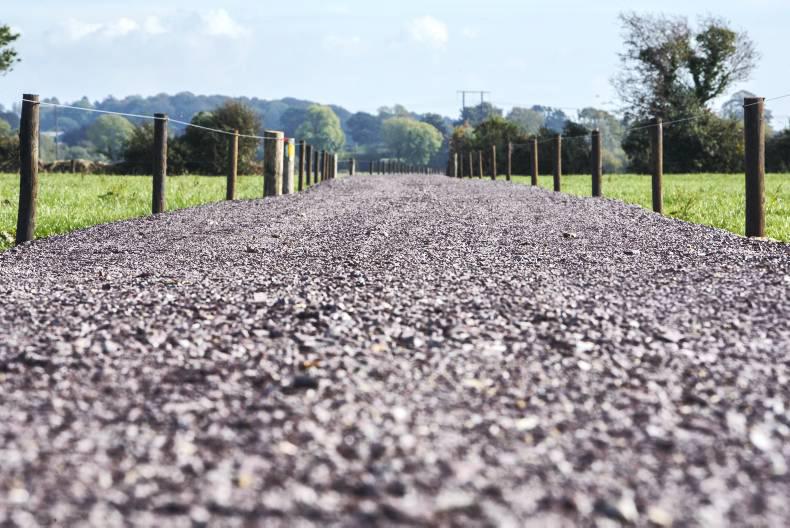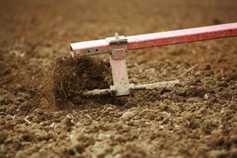Last week, we reviewed deep drainage on the farm of Con Lehane near Macroom. This week, the method of draining reviewed is different – collector drains about a metre deep and subsoiling to break up a layer of soil that shows very little signs of cracking.
The Kiskeam farm of Sean O’Riordan in north Cork has a mix of free-draining soils that are well developed and maintained (50%) and recently acquired heavy clay soil with poor permeability.
There was a requirement for substantial development work to be completed on the farm and drainage is part of that overall investment. This farm is characterised by some very steep hills and in effect the farmyard is up on a hill.
In 2014, Sean milked 90 cows, up from 75 in 2012, with 50ha farmed in total. Sean drained two 1.6ha paddocks, almost eight acres, with long drains (160m plus) going across the slope of the field about a metre deep and then he subsoiled to a depth of 0.6m every 1.5m up and down the field, linking up the collector drains.
Since 2012, the O’Riordan farm has been growing more grass as Sean invests in more and more fertiliser, but so far soil test results are not showing much improvement.
Since 2010, Sean has spent almost on average €22,000 per year on phosphorus, potassium and nitrogen, but instead of P levels in the 5.1 to 8.0 bracket, 2014 soil P results show the P levels closer to 2.0. Soil K level target is 101 to 150, but instead 2014 levels are closer to 88.
In reality over 70% of the farm has sub-optimal P levels. However, the farm is growing more grass and grass grown has lifted to 10.4t in 2014 from between 6t and 8t/ha. In 2014, stocking rate on the milking platform was 2.2LU/ha, or 1.44 overall.
Reading the test holes
Like our drainage job previewed last week, the first job is to dig test holes in the field in question. Three test holes showed a consolidated and high clay content subsoil with increased stone as you go down the soil profile.
There was some ground water inflow at depths of 1m to 1.2m, but this was not consistent in all the test holes. As there was no consistency, installing drains at that level might not be successful.
More importantly, the layer of soil between 0.3m and 0.9m below the surface is what would be described as a heavy clay with no apparent cracking. Classed as poorly permeable, it would require drainage with a mole, gravel mole or subsoiler to break up the layer. Mole drainage wasn’t really an option as there were a lot of stones present, so subsoiling was the option, with collector drains running across the slope.
Given the high cost associated with gravel moles and the level of groundwater discharge naturally helped by suitably deep collector drains, it was decided subsoiling would be adequate.
In the collector drains, 80mm pipe was used and this was covered with 800mm of 10-40mm stone and then backfilled to the surface. A single winged subsoiler was used and it was pulled uphill, crossing over the six main collector drains every 15 metres.
Existing open drains were cleaned and deepened to 1.5m to help with the outfall. The collector drains were installed on 4 to 6 July 2013 and subsoiling was carried on 22 July when the weather was very good.
Costs
The total cost of the job was €3,420. Collector drain installation took 36 hours at €45/hour, or €1,625. Drainage stone was the next big cost at 101t at €10.78/t, or €1,085 in total. Drainage pipe was €585 (€1.03/metre for 566m) and subsoiling cost €125. In reality, this was one of the lowest-cost jobs of the farms in the heavy soils program.
General Observations
High rainfall area with generally over 1,500mm annually.Locally, this type of land would be ploughed regularly at a depth of 200-225mm to improve drainage.Farm on Upper Carboniferous shale.Test holes revealed layer of heavy soil between 0.3m to 0.9m beneath surface that needed to be broken up. Hence deep drainage (like that discussed last week) was not an option and instead collector drains and subsoiling was chosen.
Last week, we reviewed deep drainage on the farm of Con Lehane near Macroom. This week, the method of draining reviewed is different – collector drains about a metre deep and subsoiling to break up a layer of soil that shows very little signs of cracking.
The Kiskeam farm of Sean O’Riordan in north Cork has a mix of free-draining soils that are well developed and maintained (50%) and recently acquired heavy clay soil with poor permeability.
There was a requirement for substantial development work to be completed on the farm and drainage is part of that overall investment. This farm is characterised by some very steep hills and in effect the farmyard is up on a hill.
In 2014, Sean milked 90 cows, up from 75 in 2012, with 50ha farmed in total. Sean drained two 1.6ha paddocks, almost eight acres, with long drains (160m plus) going across the slope of the field about a metre deep and then he subsoiled to a depth of 0.6m every 1.5m up and down the field, linking up the collector drains.
Since 2012, the O’Riordan farm has been growing more grass as Sean invests in more and more fertiliser, but so far soil test results are not showing much improvement.
Since 2010, Sean has spent almost on average €22,000 per year on phosphorus, potassium and nitrogen, but instead of P levels in the 5.1 to 8.0 bracket, 2014 soil P results show the P levels closer to 2.0. Soil K level target is 101 to 150, but instead 2014 levels are closer to 88.
In reality over 70% of the farm has sub-optimal P levels. However, the farm is growing more grass and grass grown has lifted to 10.4t in 2014 from between 6t and 8t/ha. In 2014, stocking rate on the milking platform was 2.2LU/ha, or 1.44 overall.
Reading the test holes
Like our drainage job previewed last week, the first job is to dig test holes in the field in question. Three test holes showed a consolidated and high clay content subsoil with increased stone as you go down the soil profile.
There was some ground water inflow at depths of 1m to 1.2m, but this was not consistent in all the test holes. As there was no consistency, installing drains at that level might not be successful.
More importantly, the layer of soil between 0.3m and 0.9m below the surface is what would be described as a heavy clay with no apparent cracking. Classed as poorly permeable, it would require drainage with a mole, gravel mole or subsoiler to break up the layer. Mole drainage wasn’t really an option as there were a lot of stones present, so subsoiling was the option, with collector drains running across the slope.
Given the high cost associated with gravel moles and the level of groundwater discharge naturally helped by suitably deep collector drains, it was decided subsoiling would be adequate.
In the collector drains, 80mm pipe was used and this was covered with 800mm of 10-40mm stone and then backfilled to the surface. A single winged subsoiler was used and it was pulled uphill, crossing over the six main collector drains every 15 metres.
Existing open drains were cleaned and deepened to 1.5m to help with the outfall. The collector drains were installed on 4 to 6 July 2013 and subsoiling was carried on 22 July when the weather was very good.
Costs
The total cost of the job was €3,420. Collector drain installation took 36 hours at €45/hour, or €1,625. Drainage stone was the next big cost at 101t at €10.78/t, or €1,085 in total. Drainage pipe was €585 (€1.03/metre for 566m) and subsoiling cost €125. In reality, this was one of the lowest-cost jobs of the farms in the heavy soils program.
General Observations
High rainfall area with generally over 1,500mm annually.Locally, this type of land would be ploughed regularly at a depth of 200-225mm to improve drainage.Farm on Upper Carboniferous shale.Test holes revealed layer of heavy soil between 0.3m to 0.9m beneath surface that needed to be broken up. Hence deep drainage (like that discussed last week) was not an option and instead collector drains and subsoiling was chosen.






 This is a subscriber-only article
This is a subscriber-only article










SHARING OPTIONS: